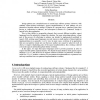Free Online Productivity Tools
i2Speak
i2Symbol
i2OCR
iTex2Img
iWeb2Print
iWeb2Shot
i2Type
iPdf2Split
iPdf2Merge
i2Bopomofo
i2Arabic
i2Style
i2Image
i2PDF
iLatex2Rtf
Sci2ools
ECOOP
2004
Springer
2004
Springer
Evolvable Pattern Implementations Need Generic Aspects
Design patterns are a standard means to create large software systems. However, with standard object-oriented techniques, typical implementations of such patterns are not themselves reusable software entities. Evolution of a program into a ‘patterned’ form (also known as ‘refactoring to patterns’) and subsequent evolution of a ‘patterned’ design is largely left to the programmer. Due to their ability to encapsulate elements that crosscut different modules, aspect languages have the potential to change this situation. For many interesting patterns, a large part of the process of refactoring to patterns can already be implemented modularly in aspects. Still, existing aspect languages can only express a small number of typical patterns implementations in a generally reusable way. In many cases, evolution of an application that uses one pattern variant into one that uses another one cannot be achieved at all. In others, it requires duplicating parts of the aspect implementatio...
Aspect Language | ECOOP 2004 | Programming Languages | Reusable Software Entities | Typical Patterns Implementations |
| Added | 01 Jul 2010 |
| Updated | 01 Jul 2010 |
| Type | Conference |
| Year | 2004 |
| Where | ECOOP |
| Authors | Günter Kniesel, Tobias Rho, Stefan Hanenberg |
Comments (0)

